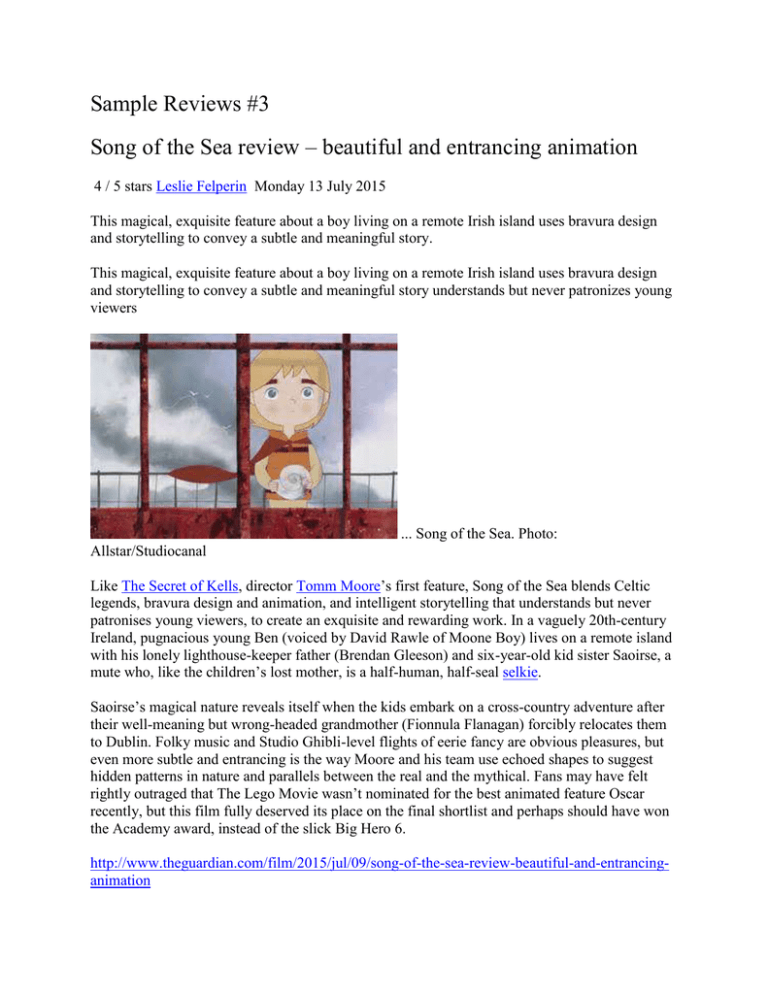Sample Reviews #3
advertisement

Sample Reviews #3 Song of the Sea review – beautiful and entrancing animation 4 / 5 stars Leslie Felperin Monday 13 July 2015 This magical, exquisite feature about a boy living on a remote Irish island uses bravura design and storytelling to convey a subtle and meaningful story. This magical, exquisite feature about a boy living on a remote Irish island uses bravura design and storytelling to convey a subtle and meaningful story understands but never patronizes young viewers ... Song of the Sea. Photo: Allstar/Studiocanal Like The Secret of Kells, director Tomm Moore’s first feature, Song of the Sea blends Celtic legends, bravura design and animation, and intelligent storytelling that understands but never patronises young viewers, to create an exquisite and rewarding work. In a vaguely 20th-century Ireland, pugnacious young Ben (voiced by David Rawle of Moone Boy) lives on a remote island with his lonely lighthouse-keeper father (Brendan Gleeson) and six-year-old kid sister Saoirse, a mute who, like the children’s lost mother, is a half-human, half-seal selkie. Saoirse’s magical nature reveals itself when the kids embark on a cross-country adventure after their well-meaning but wrong-headed grandmother (Fionnula Flanagan) forcibly relocates them to Dublin. Folky music and Studio Ghibli-level flights of eerie fancy are obvious pleasures, but even more subtle and entrancing is the way Moore and his team use echoed shapes to suggest hidden patterns in nature and parallels between the real and the mythical. Fans may have felt rightly outraged that The Lego Movie wasn’t nominated for the best animated feature Oscar recently, but this film fully deserved its place on the final shortlist and perhaps should have won the Academy award, instead of the slick Big Hero 6. http://www.theguardian.com/film/2015/jul/09/song-of-the-sea-review-beautiful-and-entrancinganimation Film Review: ‘Song of the Sea’ September 21, 2014 | 05:54PM PT Tomm Moore's follow-up to his Oscar-nominated 'The Secret of Kells' extends his fascination with lush visuals and ancient Irish legends. Peter Debruge Chief International Film Critic @AskDebruge With “Song of the Sea,” Irish animator Tomm Moore cements his place as a protector of not only Celtic culture, but classic toon forms as well. In a worthy follow-up to “The Secret of Kells” (a surprise nominee for the 2010 animated feature Oscar), Moore applies his dazzling hand-drawn style to another tale inspired by Irish legend, only this time, he spins the magic-infused yarn against a present-day backdrop while digging farther back into pre-Pictish rock drawings for visual references. Indie distrib GKids came aboard early, backing this Cartoon Saloon production, a limited-release treasure whose long-term library value similarly hinges on high-profile awards attention. Whereas American toons tend to be driven predominantly by plot and character, Moore’s work delivers on various other levels, asking formula-fed animation auds to open their minds to a more poetic experience. That said, the pic’s emotional core isn’t so different from that of a studio-made heart-tugger like “Brave.” Here, the story is centered on a lost mother figure — a half-human, half-seal creature known as a “Selkie” — who disappears into the waves one night, leaving her husband and two children with many unanswered questions. Considering the circuitous path big brother Ben (David Rawle) and his silent little sister, Saoirse, take in trying to unravel the family mystery, Moore and screenwriting collaborator Will Collins seem to be rejecting the simplified Joseph Campbell template upon which so many Western toons are modeled. The idea isn’t to shoehorn local legend into a comfortable Disney formula, but rather, to find the appropriate animated style through which to communicate his culturally specific narrative traditions. The digressions make the experience unique, while cute if somewhat simplistic-looking characters — including a massive sheepdog named Cu (Gaelic for “dog”) — ensure easy identification for young auds. “Song of the Sea” is differentiated not only by its rich visual design — grayer and more subdued than “The Secret of Kells,” yet still a marvel to behold — but also by its ethereal musical dimension, another collaboration between composer Bruno Coulais and Irish folk band Kila. Their songs and score feature seldom-heard instruments, Gaellic lyrics and verse inspired by no less an Irish figure than William Butler Yeats (specifically “The Stolen Child,” in which fairies try to lure a child into the waters). One clue to the importance of music here is the fact that although Saoirse doesn’t speak, by playing her shell flute, this curious child participates in an older, proto-linguistic tradition. (The inconsistent sound mix heard at the Toronto premiere — flat in some scenes, lush in others — could use further tuning before release.) Visually speaking, the superflat human characters recall the “cartoony” style of Genndy Tartakovsky (“The Powerpuff Girls,” “Samurai Jack”) and other popular American animated series (including “Foster’s Home for Imaginary Friends” and “Flapjack”). But these google-eyed, bobble-headed figures carry on their adventures amid lavish hand-painted environments, distinguished by their watercolor textures and lines of varied colors and widths (as opposed to the uniform ligne claire style so common in comics and cartoons), all part of artistic director Adrien Merigeau’s beautifully executed take on Moore’s vision. All these multimedia elements contribute to a uniquely immersive experience, suggesting the way a beetle might explore an elaborate tapestry at thread level, passing through segments of different colors along its winding journey. The kids’ epic quest leads them through realms populated by fairies, ancient sea gods and the owl witch Macha (Fionnula Flanagan). She’s an intimidating character, but not a clearcut villain per se, motivated as she is by an overzealous desire to eliminate suffering. Nearly all the adult voices (including a soft-spoken Brendan Gleeson) do double duty as both real and mythical characters — a nice touch in a tale designed to suggest that we’re slowly losing our ability to recognize the magic that surrounds us at all times. The pic’s poignant idea of a happy ending is one most would consider tragic, but then that’s just one more way Moore makes this song his own. http://variety.com/2014/film/festivals/film-review-song-of-the-sea-1201310423/ Whale Rider (2003) Drama, Family, Foreign Rated PG-13 by| Roger Ebert June 20, 2003 "Whale Rider" arrives in theaters already proven as one of the great audience-grabbers of recent years. It won the audience awards as the most popular film at both the Toronto and Sundance film festivals, played to standing ovations, left audiences in tears. I recite these facts right at the top of this review because I fear you might make a hasty judgment that you don't want to see a movie about a 12-year-old Maori girl who dreams of becoming the chief of her people. Sounds too ethnic, uplifting and feminist, right? The genius of the movie is the way is sidesteps all of the obvious cliches of the underlying story and makes itself fresh, observant, tough and genuinely moving. There is a vast difference between movies for 12year-old girls, and movies about 12-year-old girls, and "Whale Rider" proves it. The movie, which takes place in the present day in New Zealand, begins with the birth of twins. The boy and the mother die. The girl, Pai (Keisha Castle-Hughes) survives. Her father, Porourangi (Cliff Curtis), an artist, leaves New Zealand, and the little girl is raised and much loved by her grandparents Koro and Nanny Flowers. Koro is the chief of these people. Porourangi would be next in line but has no interest in returning home. Pai believes that she could serve as the chief, but her grandfather, despite his love, fiercely opposes this idea. He causes Pai much hurt by doubting her, questioning her achievements, insisting in the face of everything she achieves that she is only a girl. The movie, written and directed by Niki Caro, inspired by a novel by Witi Ihimaera, describes these events within the rhythms of daily life. This is not a simplistic fable but the story of real people living in modern times. There are moments when Pai is lost in discouragement and despair, and when her father comes for a visit she almost leaves with him. But, no, her people need her--whether or not her grandfather realizes it. Pai is played by Keisha Castle-Hughes, a newcomer of whom it can only be said: This is a movie star. She glows. She stands up to her grandfather in painful scenes, she finds dignity, and yet the next second she's running around the village like the kid she is. The other roles are also strongly cast, especially Rawiri Paratene and Vicky Haughton as the grandparents. One day Koro summons all of the young teenage boys of the village to a series of compulsory lessons on how to be a Maori, and the leader of Maoris. There's an amusing sequence where they practice looking ferocious to scare their enemies. Pai, of course, is banned from these classes, but she eavesdrops and enlists a wayward uncle to reveal some of the secrets of the males. And then--well, the movie does not end as we expect. It does not march obediently to standard plot requirements but develops an unexpected crisis and an unexpected solution. There is a scene set at a school ceremony, where Pai has composed a work in honor of her people and asked her grandfather to attend. Despite his anger, he will come, won't he? The movie seems headed for the ancient cliche of the auditorium door which opens at the last moment to reveal the person that the child onstage desperately hopes to see--but no, that's not what happens. It isn't that Koro comes or that he doesn't come, but that something else altogether happens. Something in a larger and more significant scale, that brings together all of the themes of the film into a magnificent final sequence. It's not just an uplifting ending, but a transcendent one, inspired and inspiring, and we realize how special this movie really is. So many films by and about teenagers are mired in vulgarity and stupidity; this one, like its heroine, dares to dream. http://www.rogerebert.com/reviews/whale-rider-2003 Whale Rider (2002) FILM REVIEW: A Girl Born To Lead, Fighting The Odds By ELVIS MITCHELL June 6, 2003 The stoic mysticism of Niki Caro's cool-handed charmer ''Whale Rider'' -- in which the young Pai must overcome resistance as she tries to assume her destiny as the leader of a tribe on the New Zealand coast -is wickedly absorbing. Much of the film's power comes from the delicate charisma of Keisha CastleHughes, making her acting debut as Pai. Ms. Castle-Hughes lacks the traditional resources of an actress, and instead communicates her feelings through a wary hesitation. It doesn't matter that her voice makes her sound a little lost, still trying to find her way into a world that disdains her. Her intelligent, dark eyes are so expressive that she has the piquant confidence of a silent-film heroine. Her instinctive underplaying gives ''Whale Rider'' an added gravity, with the lush remoteness of the landscape serving as an entrancing contrast to the sugar-rush, you-go-girl empowerment of programmed pandering like ''The Lizzie McGuire Movie,'' whose tweener heroine flails her arms and bats her eyes as if she were sending distress signals. The director demonstrates a class and tact that brand ''Whale Rider,'' which opens today in New York and Los Angeles, as more than a time-filler for young moviegoers or an ironman competition for adults accompanying them. Pai's natural rectitude -- the way she plays both pride and hurt -- is even used by Ms. Caro as a hereditary trait. Pai's prickly grandfather Koro (Rawiri Paratene) displays a contempt for her that is like a deadpan force of nature itself. Koro, the tribal chief, wanted a grandson to take on his mantle. But Pai's twin brother died in a difficult birth, which also took her mother's life, and her father, Porourangi (Cliff Curtis), has deserted the family for a career as an artist. Koro treats his granddaughter as the living embodiment of a curse. When he bothers to pay attention to her at all, it's through a sharp cutting of his eyes in her direction. Tradition dictates that the first-born grandson step into the role of chief, but Pai -- named Paikea by her father, after the tribe's ancient ancestor, who legend says arrived in the village on the back of a whale -- is all the family has. Her patient grandmother Nanny Flowers (Vicky Haughton) encourages Pai to give things time; Nanny Flowers also refuses to crumple under the galling chauvinism of her husband. But Pai has endured the suffering for all of her 12 years. And though she has a plucky physical assurance -- the firm hand of her grandmother has helped keep her demeanor strong -- she still wants the nurturing she feels is her due. Ms. Caro treats the material with the calm of a silent film and exploits the extravagant beauty of the location for its majesty. Each shot of the vistas in the breathtakingly lovely village is presented with an even clarity; Ms. Caro and her cinematographer, Leon Narbey, let the audience be seduced by the daunting power, rather than overwhelming viewers with it. With a deft hand, the director bridges the disconnect between the modern touches in the village -- like the hilarious, cranky chatter over card games -- and the determination to cling to traditions. It is evident that tradition is the way the Whangara tribe maintains its spirituality, which defines it. The critical moment comes in a set piece that has the potential to send the film off into florid, find-yourbliss sentimentality: a whale cruises too close to the shoreline and needs to be steered back into deeper, life-sustaining waters. Ms. Caro refuses to oversaturate the film with anxious hyperdramatics. It is a moment in which she must show that she trusts her young star, a faith that pays off with a disarmingly touching climax. But you will have surrendered to ''Whale Rider'' long before then. The film shows strength by tightening the rhythms of the scenes; be warned that the longueurs that surface in the first 10 minutes or so may make demands on your patience. Ms. Caro and her editor, David Coulson, obviously wanted to dissipate any feeling of forced pathos that might accompany the intense tragedy experienced by Pai's family. It's a welcome exercise of taste on the director's part. Mr. Curtis's total immersion in the role of Pai's father rescues him from the typecasting of his previous work -- playing dark-skinned bad guys of indeterminate ethnicity. His excitement alone adds a charge to the picture. Ms. Caro's attempt to fight the mawkishness inherent in the film's opening by setting a tone of emotional tidiness makes the rest of ''Whale Rider'' distinctively efficient; this gamble makes the first section seem distended and a little drab. Still, there aren't many filmmakers who would have fought that initial heightening of heartbreak. Too flamboyant an opening would have left the movie with no place to go and embarrassed us with so early a claim on our sentiments. Bear with ''Whale Rider'': once the picture kicks into gear, it has the inspiring resonance of found art. ''Whale Rider'' is rated PG-13 (Parents strongly cautioned) for scenes of emotional cruelty that may be a little upsetting for younger viewers. http://www.nytimes.com/movie/review?res=9D02E1DF1F30F935A35755C0A9659C8B63 Questions: Read, annotate, and bring this with you to class. Be ready for a quiz or in-class writing related to these questions and to other material in the reviews. 1. Identify these features in all of the reviews: thesis; evaluation; discussion of criteria; description of the film; plot summary; background about the filmmaker/team/production; context (historical, cultural, or artistic—such as discussing where this film fits in with others of its type), personal response of the reviewer. 2. Consider how the reviewer adapts the writing to a particular audience. See if you can deduce the audience from what is said and how it is said. Forum is another clue (see the URL). 3. Look at the different ways the reviews are introduced. Consider the benefits/drawbacks of each choice. 4. I didn’t include all of the photos (for space reasons), but consider the effects of the visuals I did include. 5. Do these reviews make you want to see these films? Why or why not?




